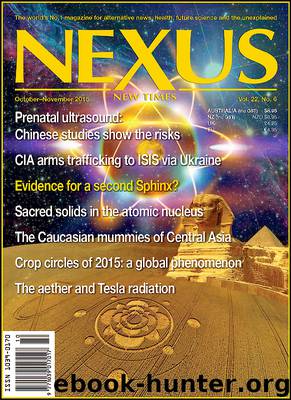Nexus Magazine - Vol 22 #6, October-November 2015 by Nexus various

Author:Nexus various
Language: eng
Format: epub
Published: 2015-10-09T16:00:00+00:00
On the Structure of Matter
Figure 1 shows the modern periodic table of the elements. Each element is characterised by its atomic number, A, which counts the number of protons (positively charged particles) in its nucleus.
This number also indicates the number of electrons (negatively charged particles) that surround the nucleus when the element is in its stable, non-ionised state. Each element is also characterised by its mass number, Z, which takes into account the number, N, of neutrons (neutral particles) in the nucleus. Therefore, Z = A + N.
Depending on the number of neutrons in their nucleus, some elements have different variants known as isotopes, with the same atomic number but different mass number.
Some isotopes are non-stable and rapidly disintegrate. Among the stable isotopes of a given element, the periodic table depicts the atomic mass of the most abundant isotope in Nature. The mass number can be generally obtained by rounding the atomic mass to the nearest integer.
The highlighted elements in the table will be discussed in the next section.
What can be said about the internal structure of any of those particles?
For example, what is an electron?
Most physicists agree that it is an entity with the property of a quantum of charge, and that we cannot infer anything about its internal composition from experiments: we are only allowed to talk about the probability of finding an electron somewhere around the nucleus.
Fortunately, as mentioned in the introduction, according to the alternative interpretation of quantum mechanics originally suggested by Louis de Broglie in 1927, it does make sense to think of quantum particles as entities with internal structure that can move in some determined— although unknown—trajectories.8
As to the internal composition of an electron, according to the research conducted by biophysicist Dr Paulo Correa and his wife, Alexandra Correa, it consists of a quantum of circularised energy in a constant flow that defines a toroidal structure.9
Dr Vladimir B. Ginzburg has also developed a simple model of all elementary charged particles in the form of a torus of varying aspect ratio.10
And what do we know about the internal composition of a proton or a neutron? Physicists don't have a way of looking inside any such particle, but from experiments in particle colliders they agree that a proton (or a neutron) is composed of three more elementary units called quarks.
So, in the domain of nuclear physics it appears to make sense to talk about the structure of a particle (ha ha ha!). In fact, some experiments conducted at the Weizmann Institute of Science have shown that electric current is quantised in units of one-third of the quantum of charge.11
So it is likely that the electron is also composed of some elementary units, but at the moment science does not know this for certain. . .yet.
I suspect that both the proton and the electron have a common internal structure, and that they only differ in size and in their internal property of charge.
They could well be scaled versions of one another. In fact, physicists hold that beta
Download
This site does not store any files on its server. We only index and link to content provided by other sites. Please contact the content providers to delete copyright contents if any and email us, we'll remove relevant links or contents immediately.
What's Done in Darkness by Kayla Perrin(26595)
The Fifty Shades Trilogy & Grey by E L James(19080)
Shot Through the Heart: DI Grace Fisher 2 by Isabelle Grey(19058)
Shot Through the Heart by Mercy Celeste(18936)
Wolf & Parchment: New Theory Spice & Wolf, Vol. 10 by Isuna Hasekura and Jyuu Ayakura(17113)
Python GUI Applications using PyQt5 : The hands-on guide to build apps with Python by Verdugo Leire(16994)
Peren F. Statistics for Business and Economics...Essential Formulas 3ed 2025 by Unknown(16878)
Wolf & Parchment: New Theory Spice & Wolf, Vol. 03 by Isuna Hasekura and Jyuu Ayakura & Jyuu Ayakura(16825)
Wolf & Parchment: New Theory Spice & Wolf, Vol. 01 by Isuna Hasekura and Jyuu Ayakura & Jyuu Ayakura(16447)
The Subtle Art of Not Giving a F*ck by Mark Manson(14353)
The 3rd Cycle of the Betrayed Series Collection: Extremely Controversial Historical Thrillers (Betrayed Series Boxed set) by McCray Carolyn(14142)
Stepbrother Stories 2 - 21 Taboo Story Collection (Brother Sister Stepbrother Stepsister Taboo Pseudo Incest Family Virgin Creampie Pregnant Forced Pregnancy Breeding) by Roxi Harding(13646)
Scorched Earth by Nick Kyme(12771)
Drei Generationen auf dem Jakobsweg by Stein Pia(10965)
Suna by Ziefle Pia(10889)
Scythe by Neal Shusterman(10339)
The Ultimate Python Exercise Book: 700 Practical Exercises for Beginners with Quiz Questions by Copy(9572)
D:\Jan\FTP\HOL\Work\Alien Breed - Tower Assault CD32 Alien Breed II - The Horror Continues Manual 1.jpg by PDFCreator(9550)
International Relations from the Global South; Worlds of Difference; First Edition by Arlene B. Tickner & Karen Smith(9522)
